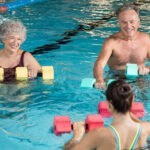Dive into fitness: Aquatic HIIT may be game-changer for people with chronic health conditions
 (NaturalHealth365) Most people have heard of high-intensity interval training (HIIT for short) in passing, yet few are aware of the aquatic version of this approach to fitness. Though the prospect of putting on a bathing suit and spending time in the water might not seem appealing to some, water-based training is ideal for those saddled by pain and other chronic health conditions.
(NaturalHealth365) Most people have heard of high-intensity interval training (HIIT for short) in passing, yet few are aware of the aquatic version of this approach to fitness. Though the prospect of putting on a bathing suit and spending time in the water might not seem appealing to some, water-based training is ideal for those saddled by pain and other chronic health conditions.
A recent study conducted by researchers at the University of Melbourne and Oslo Metropolitan University and published in BMJ Open Sport & Exercise Medicine shows underwater HIIT is especially beneficial for adults who find it challenging to exercise on land. Instead of prolonged exercise sessions, aquatic HIIT consists of brief bursts of fast-paced activity in the water followed by brief rest periods. The twist is that the exercises all occur when one is in the water instead of on his or her own feet on land.
Make a splash and discover the overlooked power of aquatic HIIT
Although HIIT has gained recognition over the past few years in fitness, its aquatic counterpart has often been in the shadows. The study above underscores that aquatic HIIT yields equivalent benefits to traditional HIIT, making it a standout choice, particularly for those with barriers to performing land-based exercises.
While not everyone has the luxury of a pool in their backyard, the unique advantages of exercising in water make the effort worthwhile. For instance, aquatic workouts offer a respite for joints under pressure. Remarkably, individuals with chronic health issues or pain often discover newfound capabilities in water, overcoming the limitations of traditional fitness settings like gyms or home setups.
Study explores how water-based HIIT boosts exercise capacity
In a systematic review covering 18 trials, researchers examined how aquatic exercise influences exercise capacity. They used methods like walking tests, fitness assessments, and precise measurements of oxygen consumption to study participants engaged in moderate-intensity water workouts. This involved comparing them with groups doing land-based HIIT and a sedentary control group.
The study was carefully crafted to include people dealing with a range of chronic health conditions, from arthritis to back pain and chronic lung disease. They even looked at participants dealing with multiple chronic health issues. What they found was intriguing: aquatic HIIT showed a moderate boost in exercise capacity compared to those who didn’t exercise.
And here’s the noteworthy part: participants reported fewer issues during water-based exercise than their land-based counterparts. This insight adds weight to the idea that exercising in water increases exercise capacity and comes with a lower risk profile.
Practical suggestions to get started with aquatic HIIT
Embarking on your aquatic HIIT journey is not just a leap into the water but a plunge into a transformative fitness experience. Here are some practical tips to ensure a smooth initiation into aquatic exercise.
- Find local classes: Explore community or gym offerings for aquatic classes. Larger cities often provide aquatic HIIT or similar in-water exercise classes.
- Safety first: If you have physical limitations or severe pain, have someone accompany you when learning HIIT exercises in the water. Water safety is paramount.
- Floaties for comfort: If you’re unsure about water safety, don’t hesitate to use floaties on both arms for added peace of mind.
- Explore alternatives: If HIIT seems challenging, consider gentler aquatic exercises. The buoyancy of water can offer a low-impact yet effective workout.
- Start gradually: Begin with shorter sessions and gradually increase intensity. Listen to your body and tailor the workout to your comfort level.
- One word of caution: For those people suffering with respiratory issues, if possible, look to try some water exercise in the ocean or an outside pool because chlorine levels (indoors) may aggravate breathing issues. In addition, if you use an indoor pool with chlorine, limit your time to only around 30 – 60 minutes and wash off – right afterwards.
Have you explored aquatic HIIT or discovered other exercises suitable for those with pain or chronic conditions? Share your experiences and thoughts in the comments below.
Sources for this article include:



